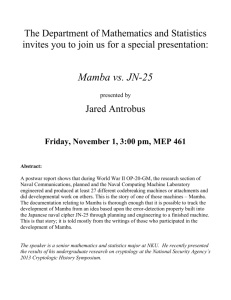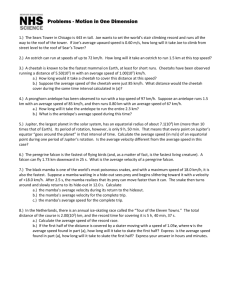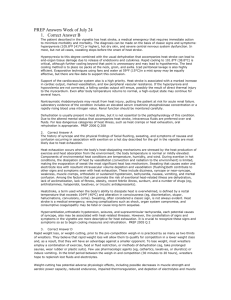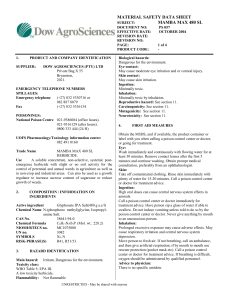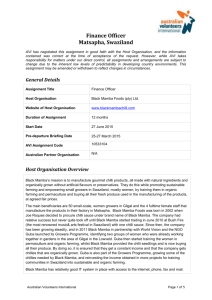Dendrotoxin
advertisement
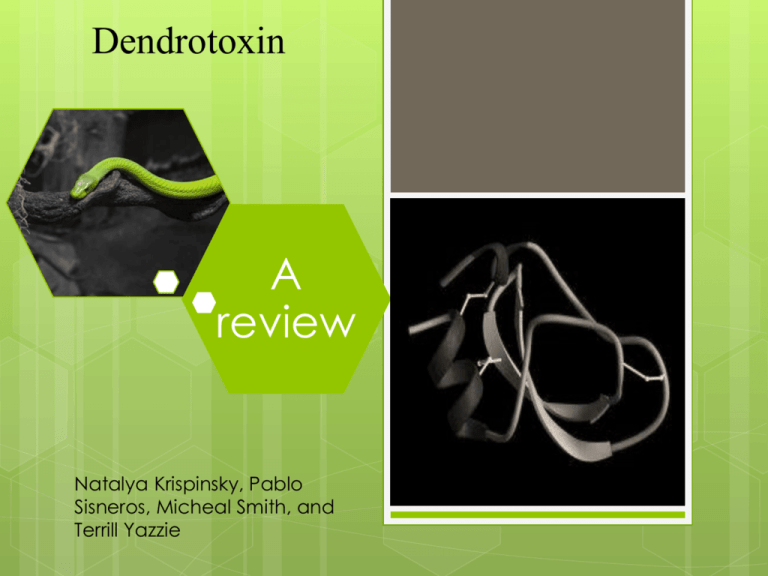
Dendrotoxin A review Natalya Krispinsky, Pablo Sisneros, Micheal Smith, and Terrill Yazzie Why we chose dendrotoxin: The potential in biological exploration The dendrotoxin is an , like many other xenobiotics, has a history to it use and discovery and continues to increase knowledge of K+ channels There is also the research into enzymatic characterization of dendrotoxins that explain how the differences of primary structure effects on function using the toxin to study multiple diseases involving mutant or nonfunctional K+ channels K+ channel sub-type involved in the disease can be isolated by exposure to specific dendrotoxin These slight differences amongst the various dendrotoxins indicates that each one has a different target among the various sub-types of K+ channels replacement of amino acid(s) in the protein structure will affect charge, conformation and action (the way the toxin molecule interacts with the target channel) Biological aspects of organisms Various snake species have evolved slightly different toxins Why we chose dendrotoxin, continued Also these methods are being used to study diabetes, Parkinson's disease, schizophrenia, Alzheimer's Including cancer Cancer research and understanding of the cell cycle Anti-cancer effects caused by disruption of cancer cell proliferation Cell cycle progression is dependent on cyclins and cyclin dependent kinases(Cdk) Dendrotoxin has inhibitory effect on Cdk Intent of study Dendrotoxin has had 20 years of research devoted to understanding this molecule, and interest has declined since. Our current investigation develops a review of past literature to present relevant information on treatment, biology, and areas of past research to understand what has been done; while indicating the areas of improvement to rejuvenate scientific significance. What is a toxin? From a pharmacological perspective, a toxin is a poison, frequently used to refer specifically to a protein produced by some higher plants, certain animals and pathogenic bacteria, which is highly toxic for other living organism. Dendrotoxin Origin Dendrotoxin is produced by the Dendroaspis genus, more commonly know as mamba's. They are primarily found in Africa • More plentiful in the red region Some tribes in Africa believe that drinking the venom can cure disease and make them more healthy. Different toxins are found between speices Black mamba dendrotoxins I, K Green mamba dendrotoxins Alpha, Beta, and Gamma and delta Basic structure of dendrotoxins 57-60 amino acids short version = 57, long = 59 or 60 cross-linked with 3 disulfide bridges Bound 1 = (30-51) Bound 2= (5-55) Bound 3= (14-38) (Hollecker et al, 1993.) Types of dendrotoxins. Alpha dendrotoxin Beta dendrotoxin Gama dendrotoxin Delta dendrotoxin Dendrotoxin I Dendrotoxin K Sequencing alignment of alpha, delta, I, and K (below). Alpha dendrotoxin Has 59 amino acids in a single chain crosslinked by three di-sulfite bridges. Inhibits a portion of the potassium current in the hippocampal pyramidal cells of the brain. It has a lysine residue near the n-terminus which is important for the role of binding to the target site. Chemical synthesized LD50 is 23 mg/kg intravenously in a mouse. Beta dendrotoxin LD50 currently unavailable Gama dendrotoxin Potassium currents that are block by this toxin are calcium dependent. LD50 is currently unavaible Delta Dendrotoxin It is 60 amino acids long It has a lysine residue near the n-terminus which is important for the role of binding to the target site. Has no effect on Inward Rectify Potassium 1 channels and fermentations in the ROMK1 protein. LD50 currently unavailable Dendrotoxin I Chemically synthesized LD50 In mice by intraperitoneal injection is 4mg/kg It can antagonize the effects of BetaBungarotoxin Dendrotoxin K High affinity for Kv family voltage-gatted K+ channels LD50 not avialable Voltage-Gated K+ channel families: Dendrotoxins affect mainly the Kv family. Common K+ channel EAG KCNQ SK slo Kv KCNQ1 KCNQ2 KCNQ3 KCNQ4 KCNQ5 eag erg elk Kv1 Kv2 Kv3 Kv4 Kv5 Kv6 Kv7 Kv8 Kv9 How does dendrotoxin affect the cell cycle? Progression through the cell cycle is ordered and directional Cyclins and Cyclin dependent kinases (Cdk) form heterodimer and function to control the cycle progression Cdk's are the catalytic subunit and cyclin is non-functional without it Cyclin D-Cdk4 is the first heterodimer formed and starts process of G1 to S progression Cells exposed to dendrotoxin showed an increase of Cdk inhibitors Cell cycle progression is halted so cells cannot replicate Dendrotoxins effect on the hypocampus Suppress a transient, voltage-sensitive, of K channels which control the outward current in hippocampal CA3 cells. The transient current initiated by depolarization exerts a shortlived hyperpolarizing influence and reduces excitability. The conductance increase associated with channel opening also reduces excitability. Mimic the action of 4Aminopyridine, but is 2000 time more effective in molar terms. Enhancement of synaptic transition in the hippocampus. Convulsive activity has been seen in the hippocampus. This is due to inhibitions of the I A which increased cell excitability. (Halliwell et al, 1986.) Dendrotoxin Facts Humans have long feared the Black Mamba, Dendroaspis polylepis, the Eastern Green Mamba, Dendroaspis angusticeps, and the Western Green Mamba, Dendroaspis viridis. Considered to be one of the world’s most venomous land snakes. Is the fastest (10-12 mph). In 1960’s death rate nearly 100% (polylepis). Unknown for other 2 spp. Estimated to be high (50-70%). Stories and legends primarily the reason it is feared and hunted (Wikipedia.org). Use in Research: Dendrotoxin proteins isolated 20 years ago. Blocks various potassium channels. Structural analogues of dendrotoxins have helped define the molecular recognition properties of different types of K+ channels, Radiolabelled dendrotoxins have also been useful in helping to discover toxins from other sources that bind to K+ channels. Because dendrotoxins are useful markers of subtypes of K+ channels in vivo, dendrotoxins are widely used as probes for studying the function of K+ channels in physiology and pathophysiology (Harvey, 2001). Routes of Administration Subdermal via snake bite. Once bitten, severe neurotoxicity ensues. Potassium-blockade effect supressed by raising the [Magnesium] or by lowering the temperature (Wu, 1989). Neurological, respiratory, and cardiovascular symptoms rapidly begin to manifest, usually within ten minutes or less. Common symptoms are rapid onset of dizziness, drowsiness, coughing or difficulty breathing, convulsions, and an erratic heartbeat. Other common symptoms are neuromuscular symptoms, shock, loss of consciousness, hypotension, pallor, ataxia, excessive salivation (oral secretions may become profuse and thick), limb paralysis, nausea and vomiting, ptosis, fever, and very severe abdominal pain. Edema is typically minimal. In cases where the victim has received larger amounts of venom than average (over 200 mg +) or the venom is delivered right into a vein, death can result within as little as 10 minutes from respiratory or cardiac arrest. Death is due to suffocation resulting from paralysis of the respiratory muscles (Strydom, 1972). First Aid In the event of a suspected or confirmed mamba bite, the following steps are recommended. (1) Carefully separate the snake from the victim and others. Killing the snake and bringing it to the hospital is not necessary, although positive identification is helpful to the medical staff. (2) A lymphatic/venous constriction bandage (pressure/immobilization) should be applied immediately. Splinting and wrapping a crepe bandage about the limb as described in Figure 2 is recommended. (3) Transport the victim to a medical facility as quickly as possible. Incisions, suction to the wound, and ice are not recommended. Appropriate measures include quieting and reassuring the victim, immobilizing the afflicted limb, and removing constricting jewelry. Rest the bitten extremity at a level at or below the victim's heart. (4) Do not remove the constricting band or crepe bandage until the victim has reached the hospital and is receiving antivenin treatment. (5) Medical facilities in the U.S. and in South Africa should have access to SAIMR polyvalent antiserum. This antivenin may be ordered from: The South African Institute for Medical Research, P.O. Box 1038, Johannesburg 2000, South Africa. Additional notes on the treatment of Mamba bites Stay calm! Receive medical intervention! Ensure inspection for multiple bites, polylepis is notorious for biting multiple times. First aid treatment includes lymphatic retardation with immobilization and pressure wrap. Medical management requires the intravenous administration of mambaspecific anti-venom. Anti-venom is hydrocortisone and polyvalent anti-venom. If allergic reaction takes place then glucocorticoids, epinephrine, and antihistamines are the mainstay for treating the reactions. Oral prednisolone is given when serum sickness occurs. Moderate symptoms do not require anti-venom; symptoms that do occur are treated accrodingly (some cases not a full dose of venom is administered). If treatment occurs later than it should permanent paralysis could ensue (Hodgson, 1996). Medical Management (1) Establish the identity of the offending snake. (2) Locate fang marks and areas of swelling and pain. Recall that the mamba is known to strike repeatedly and that multiple bites are common. (3) If a crepe bandage and splint have not been applied, apply immediately. (4) Secure 16-20 vials of SAIMR polyvalent antiserum regardless of the perceived severity of envenomation, age, or body weight of victim. There is no outside time limit for antivenin administration . (5) Admit the patient to an emergency department or other intensive care setting. If not already instituted, intubation or respiratory assistance may be necessary if respiratory distress becomes marked. Begin a peripheral IV infusion of lactated Ringer's solution at a rate sufficient to maintain a brisk urine output. (6) Draw blood from an uninvolved extremity and submit it for the tests listed in . Obtain a urine specimen for urinalysis. (7) Observe the patient. Envenomation is diagnosed by the presence of pain or inflammation or by systemic or neurological signs summarized in Tables 1 and 2. Absence of fang marks does not preclude envenomation. Conversely, presence of fang marks does not confirm envenomation since dry bites may occur. Grading envenomation in mamba bites is not useful. Any evidence of mamba envenomation is treated as diagnostic of severe envenomation. Narcotics are contraindicated since they depress respiration and alter mental status. Benzodiazepines may be used in low doses to calm the patient (Hodgson, 1996). Medical Management Continued (8) If there are no symptoms of envenomation during a I-hour observation period, remove crepe bandage and observe carefully. If any changes occur, assume envenomation. Otherwise observe the patient carefully for at least 24 h. (9) Begin antivenin therapy if mamba envenomation is diagnosed. Even if the patient was bitten several hours before, antivenin can reverse much of the venom's effects. Reconstitute 6 vials of SAIMR polyvalent antiserum in lactated Ringer's solution at room temperature. Vigorously shake the vials to insure maximum dissolution. Transfer the solution to an IV piggyback set up with a volumetric regulator. (10) A precautionary test dose of antivenin may be administered to signal the need for antianaphylaxis therapy. One ml of antiserum solution diluted in 9 ml of Ringer's solution slowly delivered via IV may be used to elicit an allergic response. Skin tests are not advised due to unreliability and needless delays in therapy. However, glucocorticoids and epinephrine should be kept available whether or not a test dose is negative. Antivenin infusion should be judiciously slowed if an allergic reaction becomes evident at any stage of therapy. (11) Infuse the diluted antivenin slowly at first, then increase to 1 vial every 7-10 min (0.7-1.0 ml/min). The crepe bandage should be removed slowly after the second vial of antivenin has been delivered. (12) Should any manifestations of allergy/anaphylaxis present themselves (e.g. cough, dyspnea, bronchoconstriction, urticaria, itching, increased oral secretions, hypotension), reduce or discontinue antivenin infusion and treat the patient with epinephrine, glucocorticoids, or antihistamines. When the patient has stabilized, resume antivenin administration at a rate tolerated by the patient (Hodgson, 1996). Medical Management Continued (13) Administer an initial course of 6 vials of SAIMR polyvalent antiserum. Then reassess the patient's condition. Stable pulse and blood pressure; Absence or amelioration of allergic reactions; EKG normal; Decrease in pain at wound; Absence of systemic evidence of envenomation; Absence of muscle fasciculations; Decrease in ptosis and other neurologic signs. (14) The key to subsequent therapy lies in the titration of antivenin against the signs and symptoms of envenomation. Symptoms that are not useful in determining the need for further antivenin therapy include circumoral tingling and slight depressions in serum potassium. These symptoms need not be corrected unless the patient becomes symptomatic. (15) Additional antivenin should be administered in three vial doses. The low neutralizing capacity of a single vial precludes the usefulness of more artful titration. Urine output should be maintained by aggressive hydration and the use of diuretics as necessary. (16) Respiratory obstruction and failure are the greatest immediate concerns. Make sure that adequate suction is available and operative at the bedside. If any sign of oropharyngeal paralysis or impaired swallowing exists nothing should be given orally. The patient should be kept on his side, head down. Intubation may be necessary to protect the airway. (17) Neostigmine provides an additional treatment option for neuromuscular junction postsynaptic blockade when used in conjunction with antivenin or as a second line alternative if antivenin is not available. Atropine is given to prevent overexcition of the autonomic nervous system. (18) Tetanus toxoid vaccination should be current. Prophylactic antibiotics are not required. (19) Patients who receive antivenin should be observed in an intensive care setting for 12-24 h. They may be discharged the following day if stable. (20) Patients who receive larger doses of antivenin might develop a cutaneous allergic reaction. This usually appears as urticaria 7-21 days after treatment. Oral antihistamines or corticosteroids may be prescribed to treat the reaction (Hodgson, 1996). Dendrotoxin as a research tool Many diseases involve mutant or non-functional K+ channels There are multiple channel types, and different varieties of dendrotoxin affect different channels This allows researchers to isolate which specific channel is affected by the disease Dendrotoxin – Alzheimers Research Abnormal K+ channel identified in brain cells of Alzheimer's patients Specific channels either not present or unresponsive to inhibition Possibly due to structural change in the binding site Current Research- Cancer • • • • • • Dendrotoxin-k suppresses tumor growth Research done in vivo Adenocarcinoma A549 cells – human lung cancer Voltage-gated K+ (Kv) channels overexpressed by cancer cells Kv 1.1 involved in cell cycle progression- G1 – S Selective knockdown of Kv1 inhibits cell proliferation Current Research Cancer - Results • • • • • Tumor volume significantly reduced when treated with dendrotoxin A549 proliferation reduced after treatment with DTX-k Expression of cyclin dependent kinase inhibitors (CDKI) increase- p21, p27,p15 CDK’s (Cyclin D1-3) involved in regulation of G1 progression Inhibition of CDK’s stop cell cycle Research into pancreatic ß-cells β-cells secrete insulin K+ channels repolarize β-cell action potential Dendrotoxin used to identify specific K+ channel mutated in mice with megencephaly (enlarged brain) – a condition in which K+ channels are known to be mutated Breast Cancer Research • • • • Multiple diseases- Kv1 channels changed in function or localization Research done in vitro Treatment with 1 , 10 nM DTX Cell proliferation reduced by 20%, 30% conclusion There is still a considerable amount of work that can be done in the area of biology to increase the knowledge of dendrotoxins. More scientific characteristics surrounding the Beta-dendrotoxin, Gamma-dendrotoxin, and dendrotoxin K still need to be addressed (ex, LD50 is unknown). Investigative efforts in these areas can help increase knowledge in cancer research by developing model binding sites that have a high affinity for cancer cells Literature Cited Benishin, C.G., Sorensen, R.G., Brown, W.E., Krueger, B.K., Blaustein, M.P., 1988. Four polypeptide components of green mamba venom selectively block certain potassium channels in rat brain synaptosomes. Mol. Pharmacol. 34, 152-159. Harvey, AL. 2001. Twenty Years of Dendrotoxins. Toxicon. 2001 Jan;39(1):15-26. Hodgson, P.S. & Davidson, T.M. 1996. Biology and Treatment of the Mamba Snakebite. Wilderness and Environmental Medicine. 2: 133-145. James V. Halliwell, Iekhsan B. Othman, Annegret Pelchen-matthews, And J. Oliver Dolly. 1986. Central action of dendrotoxin: Selective reduction of a transient K conductance in hippocampus and binding to localized acceptors, Proc. Nati. Acad. Sci. USA Vol. 83, pp. 493-497, January 1986. Jang, S., Ryu, P., Lee, S., (2011), Dendrotoxin-k suppresses tumor growth induced by human lung adenocarcinoma A549 cells in nude mice, Journal of Veterinary Science, 12, 35-40 K. Helene Vacher et al. The FASEB Journal. Research Communication. Regulation of Kv1 channel trafficking by the mamba snake neurotoxin dendrotoxin. Department of Pharmacology, School of Medicine, University of California, Davis, California, USA doi: .10.1096/fj.06-7229com M. Hollecker, D. L. Marshall, and A. L. Harvey. 1993. Structural features important for the biological activity of the potassium channel blocking dendrotoxins. Br J Pharmacol. 1993 October; 110(2): 790–794. Ma, Z., et al.,(2011). Evidence for presence and functional effects of Kv1 channels in B-cells: general survey and results from mceph/mceph mice. Plos ONE 6(4) e18213. doi:10.1371/journal.pone.0018213 Martel P, Leo D, Fulton S, Bérard M, Trudeau L-E (2011) Role of Kv1 Potassium Channels in Regulating Dopamine Release and Presynaptic D2 Receptor Function. PLoS ONE 6(5): e20402. doi:10.1371/journal.pone.0020402 Nicholls, David et al. Biochem. J. (1985) 229, 653-662 653.Printed in Great Britain.Bioenergetic actions of fi-bungarotoxin, dendrotoxin and bee-venom phospholipase A2 on guinea-pig synaptosomes. Nishio, H. and Inui, T. and Nishiuchi, Y. and De Medeiros, C.L.C. and Rowan, E.G. and Harvey, A.L. and Katoh, E. and Yamazaki, T. (1998) Chemical synthesis of dendrotoxin-i : revision of the reported structure. Journal of Peptide Research, 51 (5). pp. 355-364. ISSN 1397-002X Ouadid-Ahidouch, H., (2000). Kv1.1 K+ channels identification in human breast carcinoma cells: Involvement in cell proliferatrion. Biochemical and Biophysical Research Communications, 278, 272-277 Strydom, D. 1972. Snake Venom Toxins. The Journal of Biological Chemistry. 247: 4029-4042. Wu, C.F. et al. 1989. Actions of Dendrotoxin on Potassium Channels and Neuromuscular Transmission in Drosophila melangonaster and its Effects in Synergy with Potassium Channel-specific Drugs and Mutations. Journal of Experimental Biology. 147: 21-41. Hodgson, PS & Davidson, PM. Biology and Treatment of the Mamba Snakebite. Wilderness and Environmental Medicine. 7: 2: 133-145. http://www.biology-online.org/dictionary/Toxin http://onlinelibrary.wiley.com/doi/10.1111/j.1399-3011.1998.tb01226.x/pdf http://datasheets.scbt.com/sc-252333.pdf http://www.setonresourcecenter.com/msdshazcom/htdocs//MSDS/E/EMD/Docs/wcd00004/wcd0041d.pdf http://www.tocris.com/pdfs/pdf_downloads/potassium_review.pdf http://en.wikipedia.org/wiki/Black_mamba
